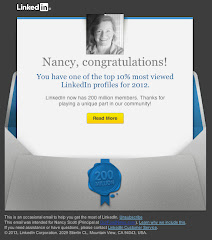In her webinar, Benun focuced on proposal writing.
Here are Benun's key points on crafting and executing a winning proposal.
Think Big.
1. Believe you are the best person for the project or don't
do it.
2. Do you have relevant experience for the client? Do you
know someone you can get inside information from? Do the prospects know what
they are looking for an what they are buying? Are the prospects just buying or
are the fishing (looking for ideas)? How many others are submitting proposals?
3. The proposal document isn't the only element of the
proposal. Also important is how you present it, how you show it.
Make Yours one of FOUR Different Types of Proposals.
1. The one-page agreement/confirmation letter (2-15 minutes)
2. One to three pages, but ideal for a new prospect offering
more details (1 hour)
3. Four to ten pages for medium to large prospect for a
client who doesn't know you. Consider hiring a professional copywriter for
this. You offer detail about your process (4 hours)
4. 10 to 20 pages for a major project with your idea client,
lots of relevant examples, demonstrates knowledge, details about people on your
team, references (1 - 2 days; generally the more pages, the higher the fee).
Definitely include samples, examples, etc.
Understand the FIVE Essential Elements of a Proposal That Must Be Included for Every Type or Size of Proposal.
1. Project description and overviews, from the prospective client's point of
view.
2. Deliverables, what will they get and how many.
3. Cost (outlined not as a Chinese menu, but with ranges of
fee for each activity).
4. A calendar for the realistic production schedule without
*specific* dates, but with length of time.
5. A sign off.
6. Other: relevant samples, images that represent your
process, references.
Demonstrate Your Process Three Ways.
1. Include The Road Map for Success: One paragraph that
describes each of the processes you will use to discover, design, develop,
implement, and evaluate the project.
2. Present a collection of checklists and forms that you
generally use in executing a project. Include, for example the marketing plan,
or the pre-press checklist. Provide screen shots only, not the actual forms (the purpose is to help the prospect understand your organizational capabilities
and skill sets).
3. Feature the bullet points of the proposal in 12 one-page
elements that include:
- Cover -- d.g. [Client Name] Rebranding Proposal, your name and address
- Short short note to so-and-so
- Project objective (short)
- Project timeline (one page.. phase one, two, three, etc.)
- Bulleted list of deliverables
- The bio and the team's bio
- A list of relevant clients
- One paragraph on a few recent projects.
- Work examples of relevant client work (three pages)
- Testimonials
- Costs (one paragraph description of each phase plus fee, in round numbers NOT ala carte)
- Proposal sign-off
-- scrubbed by Marketing Brillo
The International Freelancer's Day Conference, was presented
online on September 21, 2012, by Ed Gandia, founder of the International
Freelancer's Academy.
Through one-on-one and group mentoring, Benun provides practical
guidance, accountability and a sounding board to creative professionals who are
serious about growing their creative business. She speaks internationally to
trade groups and students. Her books include “The Designer’s Guide to Marketing
and Pricing," “Stop Pushing Me Around: A Workplace Guide for the Timid,
Shy and Less Assertive,” "The Creative Professional's Guide to Money” as
well as the popular ebooks and downloads, “The Proposal Bundle for Designers”
and “The Proposal Bundle for Copywriters.” Details at
www.marketing-mentor-toolbox.com.


